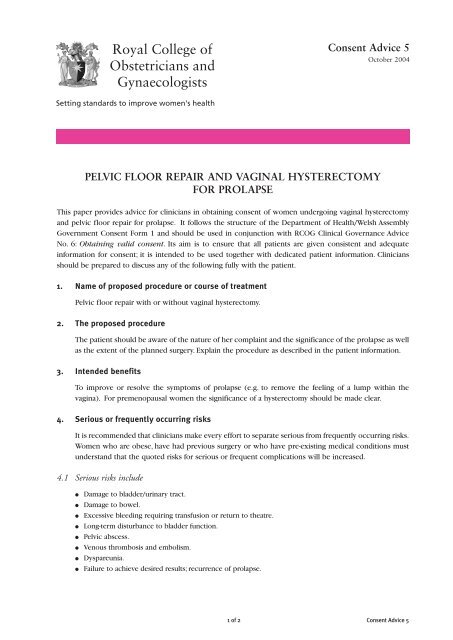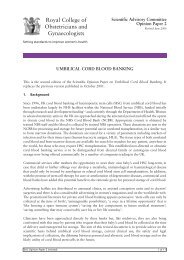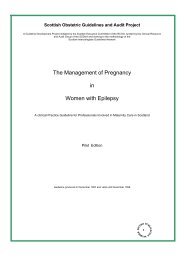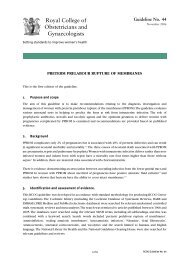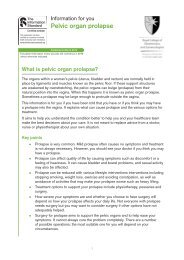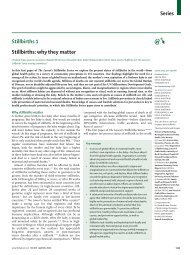PELVIC FLOOR REPAIR AND VAGINAL HYSTERECTOMY FOR ...
PELVIC FLOOR REPAIR AND VAGINAL HYSTERECTOMY FOR ...
PELVIC FLOOR REPAIR AND VAGINAL HYSTERECTOMY FOR ...
Create successful ePaper yourself
Turn your PDF publications into a flip-book with our unique Google optimized e-Paper software.
Consent Advice 5<br />
October 2004<br />
<strong>PELVIC</strong> <strong>FLOOR</strong> <strong>REPAIR</strong> <strong>AND</strong> <strong>VAGINAL</strong> <strong>HYSTERECTOMY</strong><br />
<strong>FOR</strong> PROLAPSE<br />
This paper provides advice for clinicians in obtaining consent of women undergoing vaginal hysterectomy<br />
and pelvic floor repair for prolapse. It follows the structure of the Department of Health/Welsh Assembly<br />
Government Consent Form 1 and should be used in conjunction with RCOG Clinical Governance Advice<br />
No. 6: Obtaining valid consent. Its aim is to ensure that all patients are given consistent and adequate<br />
information for consent; it is intended to be used together with dedicated patient information. Clinicians<br />
should be prepared to discuss any of the following fully with the patient.<br />
1. Name of proposed procedure or course of treatment<br />
Pelvic floor repair with or without vaginal hysterectomy.<br />
2. The proposed procedure<br />
The patient should be aware of the nature of her complaint and the significance of the prolapse as well<br />
as the extent of the planned surgery. Explain the procedure as described in the patient information.<br />
3. Intended benefits<br />
To improve or resolve the symptoms of prolapse (e.g. to remove the feeling of a lump within the<br />
vagina). For premenopausal women the significance of a hysterectomy should be made clear.<br />
4. Serious or frequently occurring risks<br />
It is recommended that clinicians make every effort to separate serious from frequently occurring risks.<br />
Women who are obese, have had previous surgery or who have pre-existing medical conditions must<br />
understand that the quoted risks for serious or frequent complications will be increased.<br />
4.1 Serious risks include<br />
●<br />
●<br />
●<br />
●<br />
●<br />
●<br />
●<br />
●<br />
Damage to bladder/urinary tract.<br />
Damage to bowel.<br />
Excessive bleeding requiring transfusion or return to theatre.<br />
Long-term disturbance to bladder function.<br />
Pelvic abscess.<br />
Venous thrombosis and embolism.<br />
Dyspareunia.<br />
Failure to achieve desired results; recurrence of prolapse.<br />
1 of 2 Consent Advice 5
4.2 Frequent risks include<br />
●<br />
●<br />
●<br />
●<br />
Urinary retention.<br />
Vaginal bleeding.<br />
Frequency of micturition and infection.<br />
Pain.<br />
5. Any extra procedures which may become necessary during the procedure<br />
●<br />
●<br />
Blood transfusion: 2 women in every 100 undergoing vaginal hysterectomy will require<br />
intraoperative blood transfusion.<br />
Other procedures:<br />
❍ o repair of bladder and bowel damage<br />
❍ o laparotomy and conversion to abdominal approach.<br />
Women must be informed that when some serious complications occur in the course of vaginal<br />
hysterectomy, e.g. bowel or bladder damage, failure to access pedicles or pelvic haemorrhage,<br />
laparotomy will be necessary to save life or prevent serious harm to future health.<br />
6. What the procedure is likely to involve, the benefits and risks of any available alternative<br />
treatments, including no treatment<br />
Pelvic floor repair and, if undergoing vaginal hysterectomy also, removal of the uterus and<br />
reconstruction of the vaginal walls, replacing the bladder and bowel in their anatomically correct<br />
position. Other therapies such as physiotherapy and ring pessary must be discussed, together with the<br />
option of no treatment.<br />
7. Information leaflet/tape<br />
A record should be made of the information leaflet/tape given to the woman prior to surgery.<br />
8. Anaesthesia<br />
The woman must be aware of the form of anaesthesia planned and be given an opportunity to discuss<br />
this in detail with the anaesthetist before surgery.<br />
9. Statement of patient: procedures which should not be carried out without further<br />
discussion<br />
Other procedures which may be thought appropriate but not essential at the time, such as removal of<br />
benign lesions, should not be performed unless discussed and consented prior to surgery.<br />
This advice was produced on behalf of the Royal College of Obstetricians and Gynaecologists by:<br />
Mr C Stewart FRCOG, Leicester<br />
and peer reviewed by seven clinicians and by representatives of the British Society of Urogynaecology, Professional Standards Committee and<br />
the RCOG Consumers’ Forum. The advice was also circulated to the clinical directors of obstetrics and gynaecology.<br />
The template was developed by the RCOG Consent Subgroup and the final version is the responsibility of the Guidelines and Audit<br />
Committee.<br />
Valid until October 2006<br />
unless otherwise indicated<br />
Consent Advice 5 2 of 2


